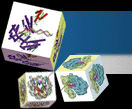| |
  |
|
|
21 |
|
DNA structures (Section 23-1A). |
|
|
22 |
|
DNA supercoiling (Section 23-1C). |
|
|
23 |
|
Transcription factor–DNA interactions (Section 23-4B). |
|
|
24 |
|
Nucleosome structure (Section 23-5B). |
|
|
36 |
|
An RNA–DNA hybrid helix (Fig. 23-3). |
|
|
37 |
|
Yeast Type II topoisomerase (Fig. 23-13). |
|
|
38 |
|
Fragment I of E. coli 5S-RNA (Fig. 23-22). |
|
|
39 |
|
A hammerhead ribozyme (Fig. 23-25b). |
|
|
40 |
|
The 434 phage repressor in complex with its target DNA (Fig. 23-32). |
|
|
41 |
|
E. coli trp repressor–operator DNA complex (Fig. 23-33). |
|
|
42 |
|
E. coli met repressor–operator DNA complex (Fig. 23-34). |
|
|
43 |
|
A three–zinc finger segment of Zif268 in complex with its target DNA (Fig. 23-36). |
|
|
44 |
|
Yeast GAL4 DNA-binding domain in complex with its target DNA (Fig. 23-37). |
|
|
45 |
|
A portion of yeast GCN4 in complex with its target DNA (Fig. 23-39). |
|
|
46 |
|
Max protein in complex with its target DNA (Fig. 23-40). |



